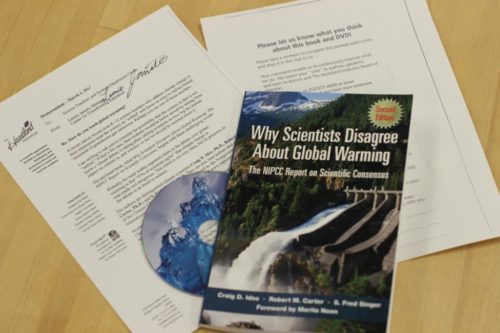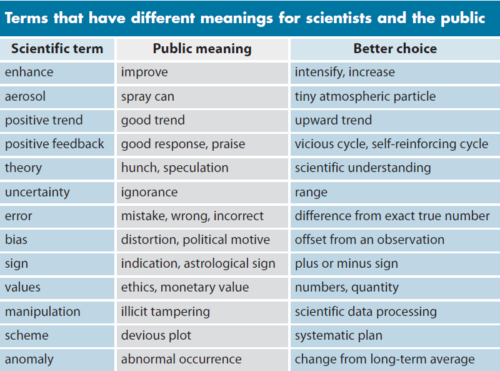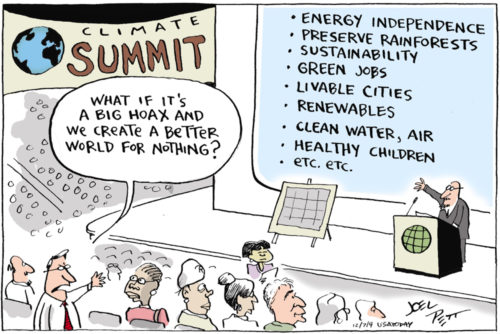Which one leads to a green future: Scientists’ effort or deniers’ gamble?
Qiurui Zhu, Juliet Nagel ·Climate change and its impacts on the environment and human well-being are getting more and more attention worldwide. The Paris Agreement aims to bring all nations into the combat with climate change and has set an ambitious goal: keeping the global temperature from rising more than 2 degrees Celsius above pre-industrial levels by the end of this century (and preferably aiming even lower, below a 1.5 degree Celsius increase). As of March 2017, 194 UNFCCC members have signed the treaty, of which 141 members have ratified it1.
In our Science for Environmental Management graduate class this past week, our discussion on the subject of climate change touched a remarkable range of topics, including the research itself, international agreements, scientist and public interaction, and even religion and morality. During this discussion, myself and another graduate student from China both agreed that most people in China believe in climate change, as we more often have warm winters and the rainfall/snowfall patterns have changed a lot in recent years. As the highest carbon dioxide emitter in the world, China has included addressing climate change in its mid- and long-term planning for economic and social development, and has promised to peak its CO2 emissions around 2030 by adjusting industrial structure, increasing energy efficiency, optimizing energy structure, and so on. China is advocating for a low-carbon and green lifestyle, and encouraging people to adopt more sustainable behaviors, such as taking public transportation and using electronic bills.
However in the United States, human-caused climate change is still fiercely debated by climate change skeptics, perhaps more so than in any other country. Climate change deniers argue that temperature rise is not the result of human activities, but has been happening naturally over the years, and they have already taken actions to spread this disinformation to the public. Recently, the Heartland Institute, a nonprofit research and education organization which is known for rejecting evidence of human-induced global warming, sent a pamphlet titled “Why Scientists Disagree About Global Warming” with a DVD, in which the human role in climate change is rejected, to approximately 25,000 science teachers nationwide.

One idea we discussed was a counterpoint to the pamphlets sent out by the Heartland Institute: should a section on climate change be incorporated into curriculum standards as a requirement for schools at the state level? It is our obligation to make our children understand that climate change is an issue caused by human activities and has huge impacts on human health and well-being. However, few primary school teachers are provided with the necessary training for such a curriculum. Where would they get this knowledge?
One of the successful examples is the Maryland-Delaware Climate Change Education, Assessment, and Research partnership, known as MADE-CLEAR. Started in September 2012, and led by faculty members in the University System of Maryland and Delaware, this program focuses on providing support for middle and high school teachers, as well as outreach to teachers and students of all ages2.
Yet climate change scientists still have a long way to go. Based on a study by researchers from Yale and George Mason universities, as of November 2016, only 70% of Americans think global warming is happening, and only 55% of all respondents believe that global warming is mostly caused by human activities3. Thus, more effective science communication with the public and policymakers is imperative. Before communicating with the public, climate scientists should learn a few tips to keep the audiences engaged in the conversation.
First of all, figure out what audiences care about. Instead of spending a lot of time explaining the melting sea ice in Antarctica and the Arctic, it is more helpful to talk about how the ice melt will affect peoples’ lives and connect with their personal interests. Second, choose words with caution. Some words may be perfectly normal to scientists but confusing or misleading to the public. For example, “uncertainty” could be interpreted by the public to mean that scientists are still not sure about the issue, and “ocean acidification” may trigger fears that people will melt if they enter the water. While it may not be a bad thing to use scary words, explaining what they mean (in the latter case by describing the pH scale) is important.

The Guardian has listed twelve tools for communicating climate change more effectively on one webpage of its climate change section4. In brief, what should be kept in mind is that narrative skills help reach people and effective communication is a conversation, rather than an argument or a lecture. Learning, developing, and practicing such communication skills is essential for climate scientists because they play a critical role in conveying the most up-to-date climate science to the public and policymakers.
The world is warming and humans are the primary cause of it. This is not conjecture, but is based on facts and evidence5. NASA and NOAA data showed that 2016 was the warmest year on record globally, and that 16 of the 17 warmest years on record have occurred since 2001. They also stated that the 1.1 degree Celsius rise of the earth’s average surface temperature since the late 19th century was largely driven by increased CO2 and other man-made emissions to the atmosphere6. It is astounding to see climate change deniers choose to ignore the facts and take such a huge gamble, putting themselves and future generations’ well-being at risk. As cartoonist Joel Pett illustrates below, the choices we make to halt climate change have a multitude of additional benefits. It is time we all work together to create a greener and healthier world.

References:
1. "Paris Agreement". United Nations Treaty Collection. 8 July 2016.
2. National Science Foundation Awards: CCEP-II MADE-CLEAR – Maryland-Delaware Climate Change Education, Assessment, and Research. Retrieved April 3, 2017, from: https://www.nsf.gov/awardsearch/showAward?AWD_ID=1239758.
3. Leiserowitz, A., Maibach, E., Roser-Renouf, C., Rosenthal, S., & Cutler, M. (2017). Climate change in the American mind: November 2016. Yale University and George Mason University. New Haven, CT: Yale Program on Climate Change Communication.
4. 12 tools for communicating climate change more effectively (July 6, 2015). Retrieved April 3, 2017, from The Guardian.
5. Richard C. J. Somerville and Susan Joy Hassol. Communicating the science of climate change. Physics Today. October 2011, vol. 64, issue 10, 48-53.
6. NASA, NOAA Data Show 2016 Warmest Year on Record Globally (January 18, 2017). Retrieved April 3, 2017, from NASA.
Next Post > Co-development of the Belmont Forum synthesis document
Comments
-
Hao Wang 9 years ago
The blog summarize the material we discussed in the class and also include some discussion about China. That is very good.
-
Stephanie 9 years ago
I think you did a great job outlining the choices and challenges we will face in presenting the reality of climate change to the American public. What I find may be the most compelling part is your information about China, our greatest economic rival that is often (ignorantly) looked down upon as "lesser" by some of the American public. I think it would be compelling to the more stubborn climate change deniers to hear that they are being unyielding to the point of idiocy, while china runs laps around all of us.
-
Kavya Pradhan 9 years ago
Nice work Qiurui! This does a really good job of highlighting the main points of our discussion last week. I'm glad to see that you brought up the Heartland institute and it's pamphlets juxtaposed it with the MADE-CLEAR efforts. We could definitely use more programs like MADE-CLEAR to counteract the misinformation and misunderstanding of the science behind climate change.
-
Katie Martin 9 years ago
Wow, NIPCC, the "Nongovernmental International Panel on Climate Change". They’ve even copied the IPCC name and acronym to try to create confusion. I agree with Ginni that it's upsetting to see the intentional spread of misinformation. I understand that mandating climate change education is impossible until there are methods in place to provide teachers with the training. It was great to hear that MADE-CLEAR exists. My discussion question on mandatory climate change education was based on my experience with the Delaware curriculum, so I'm especially glad to see this is already taking place to some extent in my home state. Good job summarizing the discussion, Qiurui!
-
Annie Carew 9 years ago
Really great job, Qiurui! I really appreciate the perspective you and Hao were able to bring to the table; in previous classes, climate change discussions were very quick to point fingers at China and India with their booming populations.
-
Jake Shaner 9 years ago
Well written blog! I like the inclusion of the comparison between the US and China in terms of public opinion to climate change. To me it seems that the US often has a lot of hubris when it comes to our place in the world. We like to play the blame game, especially with China, to hide our own inaction, despite the fact that China might actually have a better perspective/policy when it comes to climate change.
-
Ginni La Rosa 9 years ago
Very thought-provoking article. It's difficult to not feel utterly dismayed about the sheer amount of money being spent on misinformation such as the Heartland Institute's propaganda scheme, money which could be going towards real research and real problem-solving. I hadn't heard of the Maryland-Delaware education partnership until our class meeting, and I definitely plan on learning more about that program. I'm also glad to see the cartoon I mentioned in class resurface! I wasn't sure how to search for it again. It is still one of the best I have seen that addresses this point.
-
Alterra Sanchez 9 years ago
Qiurui Zhu and Juliet Nagel, nice blog! I think it made very clear that on of the biggest issues, or the biggest issue, with climate change communication is the language. It is a confusing and convoluted topic that incorporates many fields of study to be able to understand the phenomenon. The table of terms and what they mean, and than what you should say to the public, is amazing and alone shows so much how we might misunderstand how the public interprets our findings. I'll probably use this table myself! Also, I love that comic, I use it often!
-
Ana 9 years ago
I also thought rhe comparison between the US and China was really interesting. In my own country, Mexico, most people accept climate change as real but, bacause we are very close to the US, I feel like a lot of the time, we follow the United States in industrial and environmental decisions. Because of this, not much money is being invested in environmental research and mitigation measures. I'm concerned that other countries will follow the US' example in climate change debates and management and invest less and less in this very important issue.
-
Hadley McIntosh 9 years ago
Great Job! I would love to include more materials in primary and secondary schools on climate change, but I am also aware the teachers may not have the knowledge on those topics. The MADE-CLEAR program sounds really great at bridging that gap. There was a program in NSF called PERFECT GK-12 where graduate students co-taught in schools around the US. I think re-incorporating programs like that to bring scientists into schools will be key to getting our scientific messages across both to the students and their teachers.

